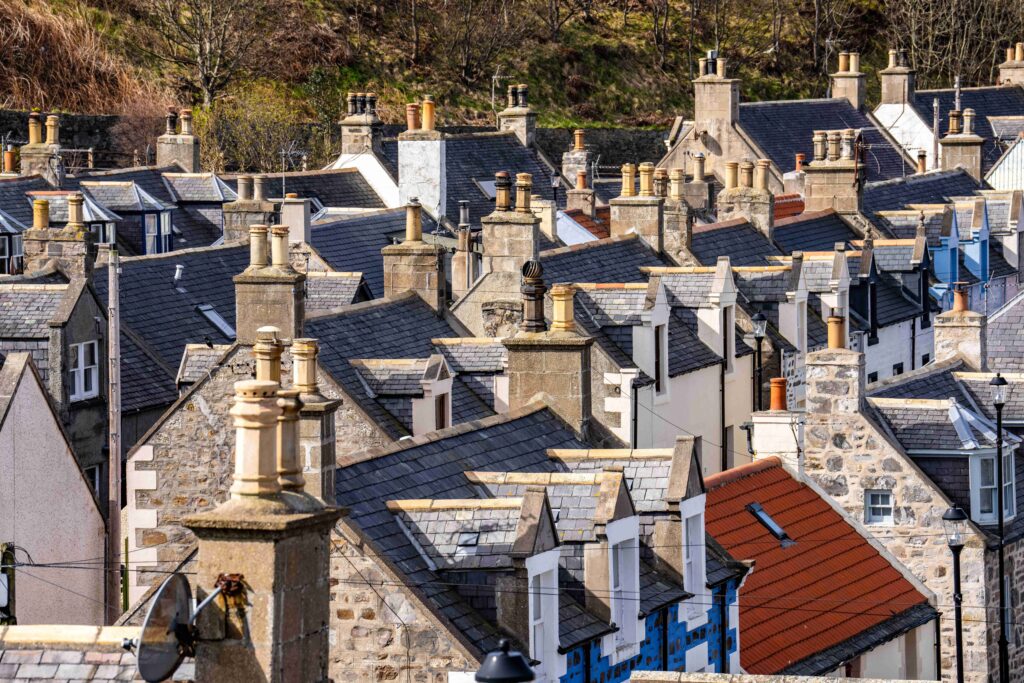- Serving London and surrounding areas
- Work for us

Choosing the right roofing material is one of the most important decisions you’ll make for your home or building. It impacts not only how your property looks, but also how it performs in the long run—affecting everything from energy efficiency and maintenance to durability and resale value.
Among the most popular roofing types today are tile, slate, and flat roofs. Each has its own unique advantages and some drawbacks. Let’s take a closer look at what makes each of these roofing options stand out—and what you need to be cautious of—so you can make an informed choice.
Tile roofing, often made from clay or concrete, is a classic choice for homeowners seeking both beauty and resilience. It’s commonly seen in warmer climates and Mediterranean-style homes.
One of the biggest strengths of tile roofing is its durability. When installed correctly and well maintained, a tile roof can last anywhere from 50 to 100 years. It also offers excellent resistance to fire, insects, and rot—making it a smart long-term investment.
Aesthetically, tile is hard to beat. Its natural texture and warm tones bring a timeless charm that suits both traditional and modern architecture. On top of that, tile has natural insulating properties. It helps regulate indoor temperatures, which can be especially helpful in hot weather.
However, tile roofing in London does come with a few caveats. First, it’s heavy—very heavy. Your home may require structural reinforcement to support the additional load, which can add to your overall installation cost. Tile is also one of the more expensive roofing materials up front. And while it’s incredibly durable, individual tiles can be fragile under pressure, making them vulnerable to cracking if walked on.
Finally, tile roofs are not the best fit for areas that experience extreme freeze-thaw cycles, as the tiles can crack under repeated expansion and contraction.
If you’re looking for a roofing material that offers both prestige and unmatched longevity, slate is a strong contender. Made from natural stone, slate tiles are associated with historic buildings, luxury homes, and timeless elegance.
A major advantage of slate is its lifespan—well over 100 years in many cases. It’s also extremely resistant to fire, water, wind, and mold. Because it’s a natural product, no two slate tiles are exactly alike, giving your roof a unique, high-end appearance that truly stands out.
Slate is also an environmentally friendly option. Since it lasts far longer than most roofing materials, it doesn’t contribute to landfill waste as frequently, and its production process has a relatively low environmental impact.
But slate isn’t perfect for every situation. Much like tile, it’s very heavy, which may require additional structural support. It’s also one of the most expensive roofing options, both in terms of material and labor. Installation requires specialized expertise, and repairs can be tricky since matching the original slate’s color and size can be difficult. And while slate is strong, it’s not immune to damage—walking on a slate roof without care can result in broken tiles.
Flat roofing offers a different aesthetic altogether. Often used in modern architecture and commercial buildings, flat roofs provide a sleek, minimalist appearance and can also serve functional purposes, like rooftop gardens, solar panel installation, or even living spaces.
One of the biggest benefits of a flat roof is its affordability. It generally requires fewer materials and less labor than pitched roofs, making it a cost-effective solution for budget-conscious homeowners or developers. Flat roofs are also quicker to install, easier to inspect, and less dangerous to walk on during repairs.
Their low profile is perfect for modern-style homes, and because of their shape, flat roofs make full use of space. You can install air conditioning units, set up solar panels, or even create a small rooftop lounge if the structure allows.
However, drainage is a challenge with flat roofs. Unlike pitched roofs, they don’t naturally shed water, so proper drainage systems are essential. Without them, water pooling can occur, leading to leaks and water damage over time.
Flat roofs also typically have a shorter lifespan than tile or slate roofs, depending on the material used (such as EPDM, PVC, or bitumen). Most will last between 10 and 25 years. They also require more frequent maintenance to prevent small issues from becoming larger problem.
Choosing the best roof depends on your location, budget, design preferences, and long-term plans.
If you value a timeless look, long life, and live in a warmer climate, tile roofing might be the right match. It adds elegance and energy efficiency to your home while offering impressive durability.
If you want a roof that could last over a century and you’re aiming for a more luxurious, classic finish, slate roofing in London is the clear winner. It’s a significant investment, but one that pays off in the long run—especially in terms of resale value and performance.
On the other hand, if you’re focused on modern design, functional rooftop use, or keeping costs lower, flat roofing could be your best option. Just be sure to work with professionals who understand proper drainage and maintenance needs.
Your roof isn’t just a protective layer—it’s a major part of your home’s identity and structural integrity. Taking the time to understand the benefits and challenges of each roofing option can save you money, frustration, and time down the road.
Whether you’re building new, replacing an old roof, or just weighing your options, always consult with experienced roofing professionals who can assess your property, explain your options, and guide you toward the best choice.
Monday to Sunday: 6:00 AM – 8:00 PM (Open Daily)
Subscribe to our newsletter for the latest updates and offers.
© [2010 [A&A Roofing]. All Rights Reserved. Designed By Spectrum Media Solutions.